Burchell’s Zebra × Horse
Was the quagga this hybrid?
Mammalian Hybrids
|
Suddenly, as rare things will, it vanished.
—Robert Browning
|
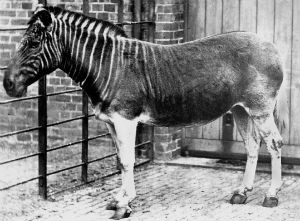 Female quagga, London, Regent’s Park Zoo (1870).
Female quagga, London, Regent’s Park Zoo (1870).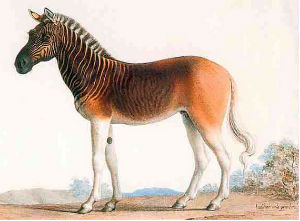 A quagga stallion in Louis XVI’s menagerie at Versailles, by Nicolas Marechal (1753 -1802), painted at Paris in 1793.
A quagga stallion in Louis XVI’s menagerie at Versailles, by Nicolas Marechal (1753 -1802), painted at Paris in 1793.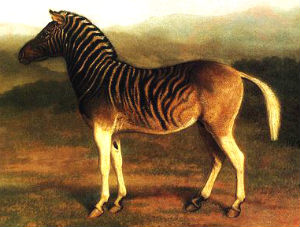 Male quagga imported from Africa to England in the early 1880s. Painted from a live specimen at the Royal College of Surgeons, commissioned by Lord Merton.
Male quagga imported from Africa to England in the early 1880s. Painted from a live specimen at the Royal College of Surgeons, commissioned by Lord Merton.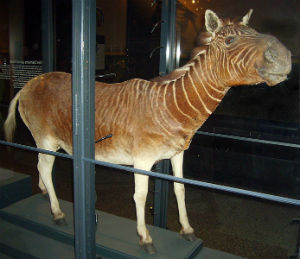 Stuffed quagga, Naturkunde Museum, Berlin (Image: Wikimedia, FunkMonk)
Stuffed quagga, Naturkunde Museum, Berlin (Image: Wikimedia, FunkMonk)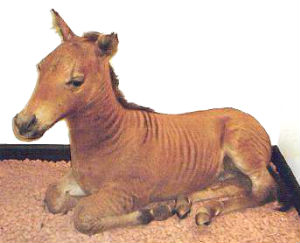 Known zorse (foal, stuffed), Rothschild Zoological Museum, Tring, England (Image: Wikimedia, Sarah Hartwell)
Known zorse (foal, stuffed), Rothschild Zoological Museum, Tring, England (Image: Wikimedia, Sarah Hartwell)Usually, the first generation (F₁) hybrids from a cross are relatively uniform, and variation only arises in later generations. However, when one or both of the parental populations are themselves variable, even the F₁ hybrids can be variable. Horses, of course, are quite variable in comparison with zebras because they exist in the form of many different breeds. So the variation observed among F₁ zorses is primarily the result of different breeds of horses being crossed, and not to variation among the zebra parents.
It may well be that quaggas are merely zorse specimens that mistaken naturalists have chosen to describe as quaggas, that is, out of all the various naturally occurring zorse specimens available, they have chosen those having a particular subset of the wider range of traits seen in zorses as a whole. In other words, it may be that they have chosen to describe as a species those individuals that fit their notion of what constitutes a proper quagga (while ignoring other hybrid specimens that don't fit the bill). In this way, a “species” could be brought into being by the simple means of a biased thought process, a form of “unnatural selection,” as it were.
It certainly wouldn't be the first time such a thing has happened. There are many such cases listed in my book on avian hybrids (McCarthy 2006). For example, two distinct types of hybrids derived in later generations from the cross between Golden-winged Warbler and Blue-winged Warbler were picked out from the general variability produced from that cross and described by ornithologists as two separate species on a similar basis.)
This hybrid, known as a zorse, has been produced many times in captivity. Keast (1965, p. 58) notes, too, that natural hybrids of this type have been repeatedly reported. Hybrid expert Annie P. Gray (1972, p. 102) says “Reciprocal crosses have occurred,” but in captivity it seems to be a bit more common for the sire to be a zebra. Hybrids are partially fertile.
In addition, there is the case of the quagga, a famously extinct equid (shown at right), which may actually be based on hybrids of this type. The quagga is usually treated either as a subspecies of Burchell’s Zebra or as a separate species in its own right. Also both are sometimes treated as southern subspecies of the Plains Zebra. Wikipedia states that “The last wild [quagga] population lived in the Orange Free State, and the quagga was extinct in the wild by 1878.”
The facts suggesting the quagga might well have been based on hybrid specimens are as follows:
First, there’s the extremely high variability of the various known specimens. Lowek (1999, vol. 2, p. 1024) notes that
Likewise, Kingdon (1979, p. 139) notes that “although only 17 mounted skins [of quaggas] are known to exist (Harper, 1945), plus a few pictures, the range of variation was evidently far greater than that of living zebra populations.”
This hyper-variability is evident even in the five specimens pictured at right. A high level of variability is characteristic of hybrid populations (see discussion of hybrid variability at right). One of these pictured specimens, a stuffed animal at the Naturkunde Museum, Berlin and labeled as a quagga, is rather similar to another stuffed specimen at the Rothschild Zoological Museum labeled as a zorse (see two lowermost photos at right).
Like Lowek, Grubb (1981, p. 7, citing Antonius 1951a; Gregory 1926; Lyon 1907; Rau 1974, 1978) notes that pelage patterns supposedly diagnostic of quaggas are present in individuals that have been classified as belonging to the population burchelli, which has been treated as a subspecies of Burchell’s zebra (a race that is itself now classified as extinct). That is, some individuals classified as quaggas closely resemble certain individuals assigned to burchelli (which is the typical situation when unrecognized hybridization between two populations is occurring, and the two are producing later-generation hybrids).
Lowek even says (p. 1025, citing Harley, 1988) that there has been some investigation of the possibility of using selective breeding of quagga-like Burchell’s zebra individuals to restore the quagga.
These facts suggest the former existence of extensive gene flow between the burchelli race and quaggas, so that the former and the latter may well have been connected by a hybrid zone, or at least by a scattered population of hybrid intermediates. So it may simply be that the burchelli “subspecies” was based on individuals in this hybrid population that were more like typical Burchell’s zebras, whereas the quagga was based on those that more resembled horses.
Mitochondrial DNA (mtDNA) from certain individuals classified as Zebra burchelli was more similar to mtDNA collected from a variety of preserved quagga skins than to that derived from some other individuals classified as Z. burchelli (see Figure 2 in Leonard et al. 2005). In other words, in a phylogeny, quagga specimens grouped with some Z. burchelli specimens, with other Z. burchelli specimens forming an outgroup. This finding means that the quaggas fall within the range of Z. burchelli mtDNA variation, which is consistent with the idea that quaggas were derived from crosses between Z. burchelli mares and E. caballus stallions. Since quaggas were wild animals, if they were hybrids, their mothers, too, would be expected to be wild animals, that is, zebra mares (though most captive hybrids have mare mothers, this cross is reversible).
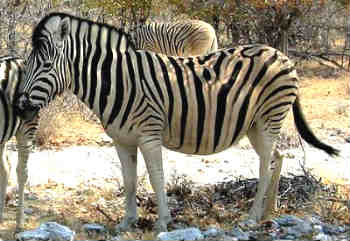 “Burchell’s Zebra” with brown markings and stripe reduction, both suggestive of horse-influenced heredity (Etosha N. P., Namibia). Enlarge image
“Burchell’s Zebra” with brown markings and stripe reduction, both suggestive of horse-influenced heredity (Etosha N. P., Namibia). Enlarge image
|
Though the facts cited thus far seem to suggest quaggas were more similar to Burchell’s zebra than to horses, some studies have argued that the quagga was more like a horse. Thus, in an analysis of skulls and dentition, Bennett (1980) reached exactly that conclusion. In a similar study, Azzaroli and Stanyon (1991) concluded Burchell’s zebra and the mountain zebra are more closely related to each other than either is to the quagga. Kingdon also says (p. 139) that quaggas and horses have thick winter coats, whereas zebras do not. And Lowek (1999, vol. 2, p. 1024) notes that they were much easier to domesticate than are zebras, a fact again consistent with the idea that they were similar to the domestic horse.
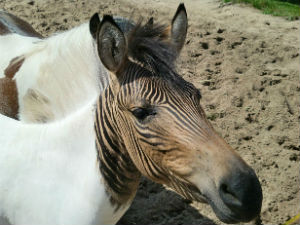 A zorse (Image: Christine und David Schmitt)
A zorse (Image: Christine und David Schmitt) |
| If the horse parent is piebald (black and white) or skewbald (other color and white), the resulting hybrid may inherit the dominant depigmentation genes for white patches (see picture immediately above). |
Thus, English naturalist Charles Hamilton Smith (1841, p. 331), who from his description of the animal is clearly talking about the quagga and not Burchell’s zebra, says,
Kingdon’s comment (see above) that only 17 quagga skins are extant suggests these animals were never abundant, despite various modern claims that they were. And from available literature, it is not easy to contradict this conclusion with any certainty. All modern sources claiming that they were plentiful in the eighteenth and early nineteenth centuries — that is, in the time of their supposed heyday — seem either to cite no substantiating source or to rely on very early sources of an anecdotal nature.
That the name quagga was often used, too, for Burchell’s zebra increases the difficulty of determining how common the animal that we call quagga today might once have been. As Bryden (1899, p. 72) relates:
Elsewhere in the same book (pp. 80-81), we find that the Boers used the same name quagga to refer both to what we call quaggas and to Burchell’s zebra:
This indiscriminate use of the name quagga has hampered my efforts to decide, on the basis of early texts, how many of these animals once existed. However, it does seem that any large quadruped represented by only 17 extant skins must have been fairly rare in South Africa in the nineteenth century. In comparison, it would not be surprising if there were thousands of surviving zebra skins from that country and dating to that time.
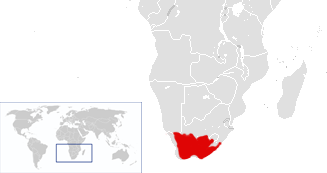 Former range of quagga, according to Wikipedia. (Map: Wikimedia, FunkMonk)
Former range of quagga, according to Wikipedia. (Map: Wikimedia, FunkMonk)Horses were first brought to South Africa by the Dutch East India Company in 1652 (Marlow 2010). In his book The Cape Horse: Its origin, breeding and development in the Union of South Africa, Schreuder (1916, p. 27) says that in South Africa during the eighteenth century “horses were allowed to run night and day in a natural state; the loss of an occasional foal through the attacks of wild animals was of minor importance.” He also states (p. 59) that as South Africans pressed deeper into the hinterlands in the early 1800s “the troops of horses were left to forage for themselves on the almost limitless pastures.” So there is every reason to think that horses would have come into regular contact with zebras during the early years of South Africa before the advent of barbed wire.
Hence, the quagga seems to have been fairly rare, and it was highly variable and morphologically intermediate between Burchell’s zebra and the domestic horse, two equids for which partially fertile hybrids are known in captivity. Moreover, the quagga occurred in a region where free-ranging horses introduced by European settlers would have come into contact with native zebras (see map right; see also zebra distribution maps here).
Indeed, contemporary experts said quaggas were horse-zebra hybrids. For example, after leaving the Big Top, celebrated animal trainer George Conklin wrote a memoir (The Ways of the Circus: Being the Memories and Adventures of George Conklin, Tamer of Lions, 1921). In it, he clearly states (p. 73) that quaggas were derived from this cross:
For all these reasons, the quagga is a putative hybrid product (PHP) of this cross.
If the various museum quagga specimens are F₁ hybrids, it should be a fairly straightforward matter to detect their hybrid status genetically. The simplest test would be to use polymerase chain reaction (PCR) to probe the nuclear DNA of any putative hybrid for the joint presence of sequences otherwise present only separately, either in horse or zebra. Their joint presence would conclusively demonstrate that the specimen was a hybrid. I look forward to some laboratory carrying out the necessary tests.
Why did the quagga disappear? If the quagga actually was a hybrid of this type, its disappearance might have been the result, at least in part, from a general decline in the South African horse breeding industry that occurred in the latter half of the nineteenth century. Schreuder (1916, p. 37) notes that during this period
A major factor in this decline was the decimation of herds by African horse sickness, a disease communicated by mosquitoes that, according to Schreuder, wiped out huge numbers of horses during the mid-1800s and prompted many horse breeders to switch to sheep, goat or ostrich breeding. Thus, Schreuder (p. 47) states the following:
Obviously, a sharp decline in the horse population of South Africa would result in a sharp decline in the production of horse-zebra hybrids there, so this may be a major reason the quagga went “extinct” in the 1870s, the date usually given.
Another factor would have been the invention of barbed wire, first patented in the United States in 1867. The increasing use of this cheap fencing during the late nineteenth and early twentieth centuries drastically decreased the number of free-ranging horses worldwide. In South Africa this new trend would obviously have contributed to the physical separation of zebras and horses, which would, of course, have prevented, or at least greatly reduced, the production of hybrids. Schreuder (1916, p. 26) began his history of South African horse breeding with a discussion of the open-range period, which he called the pastoral phase. As he comments,
As in other countries, barbed wire and modern agricultural practices brought this phase of South African ranching to an end. And with the waning of this old style of life, it would be no surprise if a “species” based on naturally occurring zebra-horse hybrids also vanished.
Another “extinct species” that’s a likely hybrid >>
Video: Brown-tinted quagga-like Burchell’s zebras at Kruger National Park.References: Anonymous 1901; Bauer 1941; Breen and Gill 1991; Cavassa 1931a; Crew and Smith 1930; Darwin 1868 (vol 2., p. 42); Flower 1929a (p. 253); Gray 1972, p. 102; Grubb 1981; Hesse 1899; International Zoo Yearbook 1961, 1969 (p. 233), 1970 (p. 266), 1977 (p. 322); Kaminski 1970; King et al. 1966; Kingdon 1979 (illustration facing p. 139); Krizenecky 1926; Przibram 1910; Riley 1910; Rörig (1903, p. 218); Schreuder 1916; Sclater 1903; Tegetmeier and Sutherland 1895; Treus et al. 1963; Weir 1888a; Zuckerman 1953. Internet Citations: GREE1†.
Note: All extant pictures of “quaggas” held in the London Zoo are collected in Edwards (1995). Lowek 1999 (p. 1023) pictures an intermediate between quagga and E. burchelli.
Most shared on Macroevolution.net:
Human Origins: Are we hybrids?
On the Origins of New Forms of Life
Mammalian Hybrids
Cat-rabbit Hybrids: Fact or fiction?
Famous Biologists
Dog-cow Hybrids
Prothero: A Rebuttal
Branches of Biology
Dog-fox Hybrids